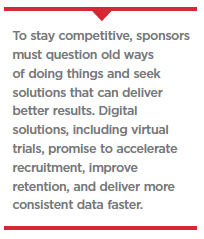 The pharma industry has been talking about the benefits of virtual trials for years, but it’s only recently that the promise of conducting complex efficacy studies in patients’ homes has finally become a reality.
The pharma industry has been talking about the benefits of virtual trials for years, but it’s only recently that the promise of conducting complex efficacy studies in patients’ homes has finally become a reality.
Industry leaders began singing the praises of virtual models around 2012, shortly after Pfizer conducted the first-ever randomized clinical study that managed participants using mobile phones and the Internet. The potential benefits were tantalizing, and for a while, everyone was talking about how this new approach would change clinical research forever.
But within a couple of years, the virtual trial hype had peaked with little to show for itself. Few trials had actually been conducted, and by 2015 virtual trials had become a pipe dream for the future.
But that future has officially arrived. We are beginning to see real results from ongoing virtual trials as more stakeholders embrace the flexibility of this model.
The Promise of Virtual Trials
Virtual models leverage telemedicine, remote data-capture devices, the Internet of Things, home healthcare professionals, and delivery services to expand geographic  reach and provide all or nearly all the clinical trial experience to patients in the comfort of their own homes. This doesn’t just make it more convenient to be a part of clinical research. It addresses one of the biggest challenges trial sponsors have struggled with for decades: recruiting.
reach and provide all or nearly all the clinical trial experience to patients in the comfort of their own homes. This doesn’t just make it more convenient to be a part of clinical research. It addresses one of the biggest challenges trial sponsors have struggled with for decades: recruiting.
Finding patients who meet inclusion/exclusion criteria then enticing them to participate in time-consuming research that interrupts their daily lives is a constant battle. One 2015 study found almost one in five trials were closed or terminated early because they could not enroll enough patients, and another shows dropout rates can hit up to 40% due in part to the inconvenience of participation.
In the face of such grim statistics, virtual trials offer a real, disruptive alternative.
In a virtual trial model, principal investigators and healthcare staff interact remotely with patients using televideo for live conversations, web-based documents, online questionnaires, chatbots, message boards, and other familiar communication tools. Patients can receive investigational medication at their homes and transmit data via wearable devices that can track heart rate, blood pressure, activity, sleep, glucose levels, medication use, and dozens of other data points.
The virtual trial model does more than create simple conveniences for patients. It changes the entire research experience, making participation in clinical research a seamless part of life rather than a burdensome detour. Patients face far fewer obstacles to participation and can enjoy the experience of being a part of the research process and potentially accessing a vital care option with very little effort on their part.
In turn, sponsors experience significant time and cost savings through reduced site overhead and a more accelerated recruiting process. They also benefit from cleaner more consistent data, which allows investigators to rapidly identify trends related to safety and clinical outcomes. All of this leads to greater operational efficiency and measurable business results.
The Many Benefts of Virtual Trials Aren’t Hypothetical
The industry has already delivered several successful virtual trials for treatments and diagnostics in diabetes, central nervous system conditions, dermatology, pulmonary disease, Alzheimer’s disease, and others. And we are currently exploring using digital therapy devices that would allow investigators to monitor the condition of remote patients who are dealing with severe cognitive impairment.
However, many stakeholders continue to be wary of such a radical change in their clinical research process. This hesitancy makes sense. In a highly regulated environment, change can equate to risk and uncertainty, which makes sponsors and regulators nervous.
Fortunately, virtual trials do not have to be an all-or-nothing scenario.
Many sponsors are easing into this transition through hybrid virtual trial models, in which some of the traditionally face-to-face features of a trial are conducted remotely. Virtual trials have so many independent features that sponsors can test whichever elements best meet their patients’ needs.
For example, patients might complete initial recruiting paperwork and/or surveys via secure online platforms, wear remote sensors for data collection, or complete some visits via telemedicine platforms while other visits are conducted at a physical site. Sponsors may also enable patients to complete lab tests or scans at pre-approved community treatment facilities rather than requiring them to travel to a central research facility.
These small changes reduce the number of on-site visits, which lessens the travel burden for patients, frees principal investigators to support more patients or to  conduct more research studies, and provides them with more and better data via remote devices. All of these benefits improve the clinical research experience for everyone involved.
conduct more research studies, and provides them with more and better data via remote devices. All of these benefits improve the clinical research experience for everyone involved.
As virtual trials go mainstream, these hybrid models can be a solution for sponsors who are curious about the time and cost savings that can be achieved but aren’t ready to embrace a fully virtual study. By starting small with low-risk virtual trial elements, they can demonstrate to regulators, auditors, and internal stakeholders that these models meet all data quality and safety requirements while delivering time and cost savings and potentially reducing the risk of patient attrition.
Hybrid virtual trials can also accommodate global trials where virtual models may only be appropriate for certain countries or arms, or for trials that only require face-time early in the process. For example, in one study of patients with bipolar disorder, the sponsor conducted the first patient visits on-site while implementing extensive digital outreach tools to transition to a virtual option. By the fourth visit, PIs conducted all interactions virtually, and patients had ongoing access to remote support teams if they had questions or needed support.
Other sponsors are adopting hybrid models for highly complex trials, such as oncology research, that require close patient monitoring and some treatments in designated healthcare facilities. Even in these trial settings, they are discovering that certain elements of the trial, including remote data collection and paperwork, can be conducted virtually. These adaptable solutions ensure PIs still have all the access they need to patients and can gather more data via remote devices while minimizing disruption to patients’ lives.
Guide to Virtual Trial Suitability
Every trial is unique and, while a fully virtual trial might not be appropriate for all, our experience suggests most trials have the potential to integrate some virtual elements. These small changes can drive time and cost benefits while lessening the burden on patients and investigators.
The trick is figuring out which elements will work in a virtual environment — and be acceptable to all decision-makers. These choices should be made early in the study design process and with the support of experts who have deep industry experience and understand where and when virtual elements are appropriate and will deliver the necessary safety and data quality.
We’ve worked with many clients who begin this decision-making convinced that a 100% virtual model is the right choice, only to have them veer toward a split, with X percent of visits done on-site and Y percent virtually, and eventually fall somewhere in the middle. This is an ideal scenario because it means decision-makers are thinking through the expectations of patients, PIs, and regulators, and making choices that will accommodate all their needs.
While every solution will be different, these discussions usually begin from a baseline assumption about where the trial will fall on a virtual model scale:
Suitable for Virtual Trials. If the trial features indications and protocols where the IP has a known safety profile and endpoints that are attainable through remote assessments, it is a good candidate for a fully virtual model. These studies often involve treatments for chronic diseases with stable patient populations and those requiring short-term monitoring. Common disease categories include endocrinology, central nervous system disorders, dermatology, respiratory conditions, gastrointestinal issues, immunology, cardiovascular disease and rare diseases, plus observational studies.
Possibly Suitable for Virtual Models/Hybrid. In more complex disease studies involving innovative therapies and long follow-up periods, a hybrid model may be more appropriate to allow sponsors to leverage the benefits of remote technology-enabled visits and data collection while still engaging in some on-site appointments. Some examples include blood cancers, Alzheimer’s disease agents, and cell therapies that require years of monitoring.
Not Suitable for Virtual Models. If the IP has an unknown safety profile and/or endpoint assessments that cannot be validated via remote assessment and/or interventions that must be conducted in an ICU, Phase I unit, or other structured setting, virtual models are unlikely to be appropriate. These types of studies include early-phase oncology treatments, first-in-human studies, and any treatments that require an ICU or cath lab.
Real-World Examples
We’ve already seen fully virtual and hybrid models work successfully in several cases. In 2016, IQVIA led a virtual trial studying remote detection of Alzheimer’s disease using a telehealth platform to conduct endpoint validation in prodromal patients. When comparing the quality of endpoint data collected remotely to standard in-person encounters, the virtual model delivered faster recruitment and demonstrated economic, scientific, and social benefits.
That same year, Sanofi completed a totally virtual Phase 4 diabetes trial, called VERKKO, which included 60 patients recruited through Facebook. The trial required no site visits, and patients registered via electronic patient information tools and signed informed consent forms electronically. Study materials were delivered to their homes, and patients transmitted data via a wireless glucose meter. The results exceeded expectations, with an 81% conversion rate among patients who showed interest in participating and less than 10% dropout rate.
In an ongoing respiratory study, IQVIA researchers are deploying technology to collected sensor data, actigraphy data, electronic patient-reported outcomes, or ePROs, and climate data to test algorithms affecting the delivery of care.
Virtual trials can be a daunting proposition in a risk-averse, highly regulated environment, but the potential benefits are impossible to ignore. To stay competitive, sponsors must question old ways of doing things and seek solutions that can deliver better results. Digital solutions, including virtual trials, promise to accelerate recruitment, improve retention, and deliver more consistent data faster. In an era where speed and cost are huge challenges, virtual trials could be the new frontier, paving the way for the future of healthcare.(PV)
IQVIA is a leading global provider of advanced analytics, technology solutions and contract research services to the life sciences industry.
For more information, visit iqvia.com
















